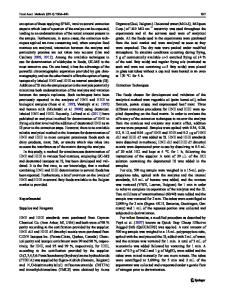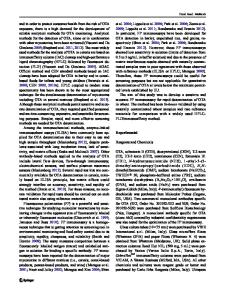Development of a new LC-MS method for accurate and sensitive determination of 33 pyrrolizidine and 21 tropane alkaloids
- PDF / 2,006,569 Bytes
- 13 Pages / 595.276 x 790.866 pts Page_size
- 88 Downloads / 378 Views
RESEARCH PAPER
Development of a new LC-MS method for accurate and sensitive determination of 33 pyrrolizidine and 21 tropane alkaloids in plant-based food matrices Zbynek Dzuman 1 & Petra Jonatova 1 & Milena Stranska-Zachariasova 1 & Nela Prusova 1 & Ondrej Brabenec 1 & Alena Novakova 1 & Marie Fenclova 1 & Jana Hajslova 1 Received: 16 June 2020 / Revised: 15 July 2020 / Accepted: 27 July 2020 # Springer-Verlag GmbH Germany, part of Springer Nature 2020
Abstract Setting of maximum limits for a number of plant alkaloids is under discussion in the EU. The novel method developed and optimized in this study enables simultaneous determination of 21 tropane alkaloids (TAs) and 33 pyrrolizidine (PAs) together with their N-oxides (PANOs). For analysis of aqueous-methanolic extract, reversed phase ultra-high-performance liquid chromatography and tandem mass spectrometry (RP-U-HPLC-MS/MS) was employed. The method was validated for frequently contaminated matrices (i) sorghum, (ii) oregano, and (iii) mixed herbal tea. The recoveries at two spiking levels were in the range of 82–115%, 80–106%, and 78–117%, respectively, and repeatabilities were less than 19% for all analyte/matrix combinations. As regards the achieved limits of quantification (LOQ), their values were in the range of 0.5–10 μg kg−1. The crucial problem encountered during method development, co-elution of multiple groups of isomeric alkaloids, was overcome by subsequent sample separation in the second chromatographic system, hydrophilic interaction liquid chromatography (HILIC), providing different separation selectivity. Lycopsamine, echinatine, and indicine (co-elution group 1) and N-oxides of indicine and intermedine (co-elution group 2), which could not be resolved on the commonly used RP column, were possible to separate fully by using the HILIC system. Keywords Pyrrolizidine alkaloids . Tropane alkaloids . Isomers . Food matrices . Tandem mass spectrometry . Hydrophilic interaction liquid chromatography
Introduction In the recent years, based on the request of European Commission, the Panel on Contaminants in the Food Chain (CONTAM) from the European Food Safety Authority (EFSA) has completed several scientific opinions on possible risks associated with tropane (TAs) and pyrrolizidine alkaloids (PAs) in various foods/feeds [1–5]. With regard to concerns about health risks related to a dietary exposure to these
Electronic supplementary material The online version of this article (https://doi.org/10.1007/s00216-020-02848-6) contains supplementary material, which is available to authorized users. * Jana Hajslova [email protected] 1
University of Chemistry and Technology, Technicka 5, 166 28 Prague, Czech Republic
plant toxins, the discussion has been initiated on setting the maximum limits for some food commodities in which elevated levels of PAs or TAs have been frequently reported. As regards PAs, regulation is being proposed mainly for herbal teas, infusions, and some plant-based supplements, as frequent and high end consumers might get doses ca
Data Loading...











